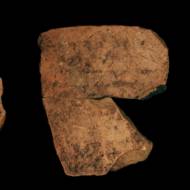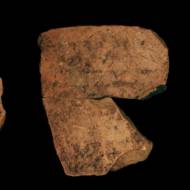
Israelis Discover 12 Ancient Inscriptions Showing Widespread Literacy During First Temple Era

Police forensic handwriting expert teams up with archaeologists to make major discoveries about life during biblical times.
By Yakir Benzion, United With Israel
A handwriting expert from the Israel Police teamed up with archaeologists from Tel Aviv University in a groundbreaking new study announced Wednesday that showed far more people in the ancient Kingdom of Judah were literate than previously thought.
It appears to be the first time modern day police and researchers examining the biblical period around 600 BCE have worked together. Their results show that literacy was not the exclusive domain of a handful of royal scribes.
The police experts were brought in to examine ink-inscribed pottery shards from an excavation of the Tel Arad military post on the southern border of the kingdom of Judah that housed 20 to 30 soldiers. The archaeological dig is a well-known historic site with the remains of a fortified city that dates from the early Bronze Age.
The pottery shards were found in the 1960s and are from when the site was used by forces of the kingdom.
Researchers compared the algorithmic methods with forensic results and brought in forensic specialist Yana Gerber, who served for 27 years in the police’s forged documents unit. She to read the pottery fragments that were discovered at the Tel Arad site in the 1960s. Gerber found that the writings were by 12 different people, with varying degrees of certainty.
“This study was very exciting, perhaps the most exciting in my professional career,” said Gerber, who happens to have degree in classic archaeology and ancient Greek. “These are ancient Hebrew inscriptions … utilizing an alphabet that was previously unfamiliar to me.”
“I delved into the microscopic details of these inscriptions written by people from the First Temple period, from routine issues such as orders concerning the movement of soldiers and the supply of wine, oil and flour, through correspondence with neighboring fortresses, to orders that reached the Tel Arad fortress from the high ranks of the Judaite military system. I had the feeling that the time stood still and there was no gap of 2,600 years between the writers … and ourselves,” she said.
Gerber explained that “writing patterns are unique to each person and no two people write exactly alike.” She examined the microscopic details of each inscription down to the spacing between each letter.
“We were in for a big surprise: Yana identified more authors than our algorithms did,” Dr. Arie Shaus said.
The findings shed new light on Judaite society on the eve of the destruction of the First Temple – and on the setting of the compilation of biblical texts.
“We can conclude that there was a high level of literacy throughout the entire kingdom,” Shaus said, adding the fact that so many soldiers were literate points to “the existence of an appropriate educational system in Judah at the end of the First Temple period.”
“If in a remote place like Tel Arad there was, over a short period of time, a minimum of 12 authors of 18 inscriptions, out of the population of Judah which is estimated to have been no more than 120,000 people, it means that literacy was not the exclusive domain of a handful of royal scribes in Jerusalem,” said archeologist Prof. Israel Finkelstein.
HELP ISRAELIS BATTLE CORONA!
Donate to the Corona Emergency Relief Fund. Coronavirus has taken a huge toll on the people of Israel. The poor, elderly and ill are most vulnerable.
Israeli soldiers, security officers and medical care providers operate under great danger and risk to life.
Over 1 million Israelis are out of work. Many cannot make ends meet. We provide financial aid, food, medical supplies and more. Funds are distributed where needed most. The time to act is now!
United with Israel